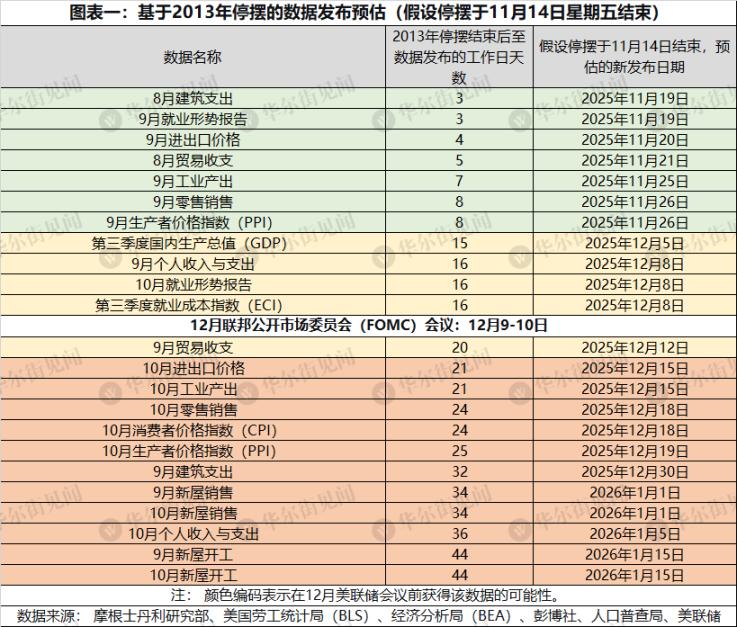Author: Long Yue Source: Wall Street News
As the US government shutdown nears its end, market focus is shifting from the political deadlock to the timing of the release of backlogged economic data and its impact on the Federal Reserve's December interest rate decision.
According to TrendFocus, Morgan Stanley, in a research report released on November 10th, predicted the release schedule for key economic data based on its experience in 2013. The report indicated that once the government resumes operations, the delayed economic data will begin to be released gradually.
According to the report's projections, if the government ends the shutdown on November 14th (Friday):
The September jobs report is expected to be released around November 19th, three business days after the shutdown ends. This will be the first major data release the market will see.
September retail sales and PPI: will be released around November 26, the 8th working day after the shutdown ends.
Third-quarter GDP: will be released on the 15th working day, December 5.
October jobs report: likely to be released on the 16th business day, December 8 (the day before the Fed meeting).
The report emphasizes that because the shutdown covered the entire month of October, the data collection delays for October may be more severe than in 2013, and there is a risk of further postponement of the release date. For example, October retail sales and CPI data may not be available until December 18, after the Federal Reserve meeting.


The "data puzzle" of the December rate cut: What can the Fed see?
For investors, the most crucial question is how much information the Federal Reserve will have at its December 9-10 meeting.
According to Morgan Stanley's analysis, the Federal Reserve will almost certainly receive September's employment, inflation (PCE), and retail sales data, as well as some trade and manufacturing indicators. Furthermore, the preliminary Q3 GDP figure and the October employment report may also be released before the meeting. The report even suggests that the November employment report may be released on time or close to time.
However, policymakers will face a severe lack of data for the fourth quarter. Aside from auto sales figures, official data on fourth-quarter personal spending was virtually nonexistent prior to the meeting.
Morgan Stanley benchmark forecast: 25 basis point rate cut in December
Despite data delays, Morgan Stanley maintains its core view that the Federal Reserve will cut interest rates by 25 basis points at its December meeting.
The report argues that the key factors driving the Federal Reserve to continue cutting interest rates are weak labor demand and rising unemployment. Morgan Stanley predicts that non-farm payrolls will increase by only 50,000 in September, with the unemployment rate remaining at 4.3%; while the unemployment rate will rise further to 4.5% in October and November. These signs of "mild easing" in the labor market will be sufficient to support the Fed's actions.
The asymmetric risk faced by investors: when "good news" becomes "bad news".
The report points out the "asymmetric risks" currently facing the market. Federal Reserve Chairman Powell made it clear at the October meeting that a December rate cut is far from a certainty, and the committee will rely more heavily on data.
This means:
If the data is weak: Since the market has already priced in the rate cut, weak data that meets expectations (such as slower job growth) will not trigger sharp market volatility unless the data shows a sharp economic downturn (such as a surge in layoffs).
If the data is strong: This is where the real risk lies. If the job market unexpectedly accelerates again (e.g., a strong rebound in non-farm payrolls and a decline in the unemployment rate), it will directly challenge the prevailing narrative of interest rate cuts. In this scenario, the market will be forced to rethink the Fed's policy rate path, potentially leading to a repricing of interest rate futures and putting pressure on risk assets.
In conclusion, after the data reverts to normalcy, market attention will be highly focused on the labor market. For investors, the "good news" (strong economy) in the economic data coming weeks could actually become the "bad news" that triggers a market correction.





